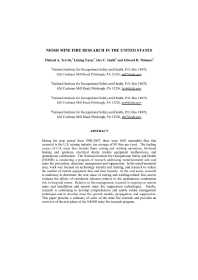Mining Publication: NIOSH Mine Fire Research in the United States
Original creation date: November 2009
During the time period from 1990-2007, there were 1601 reportable fires that occurred in the U.S. mining industry (an average of 89 fires per year). The leading causes of U.S. mine fires include flame cutting and welding operations, frictional heating and ignitions, electrical shorts, mobile equipment malfunctions, and spontaneous combustion. The National Institute for Occupational Safety and Health (NIOSH) is conducting a program of research addressing metal/nonmetal and coal mine fire prevention, detection, management and suppression. In the metal/nonmetal area, work was focused on technology transfer and training, and research to reduce the number of mobile equipment fires and their hazards. In the coal arena, research is underway to determine the root cause of cutting and welding-related fires and to evaluate the effects of ventilation schemes relative to the spontaneous combustion risk in longwall mines. Relative to fire management, research is ongoing on remote mine seal installation and remote mine fire suppression technologies. Finally, research is continuing to develop comprehensive and usable smoke management techniques and to develop mine fire growth models, propagation, and suppression. This paper presents a summary of some of the mine fire research and provides an overview of the next phase of the NIOSH mine fire research program.
Authors: MA Trevits, L Yuan, AC Smith, ED Thimons
Conference Paper - November 2009
NIOSHTIC2 Number: 20036215
Mine Ventilation: Proceedings of the Ninth International Mine Ventilation Congress, New Delhi, India, November 10-13, 2009. Panigrahi DC, ed., New Delhi, India: Oxford & IBH Publishing Co. Pvt. Ltd., 2009; 1:357-366
See Also
- Analysis of Mine Fires for All U.S. Metal/Nonmetal Mining Categories, 1990-2001
- Dust Control Handbooks for Coal Mining and Metal/Nonmetal Mining
- Fire Detection
- Historical Mine Disasters
- Innovative Strategies for Mine Fire Preparedness
- Performance-Based Fire Safety Designs for Self-Escape in Underground Mines
- Risk Profile of Cumulative Trauma Disorders of the Arm and Hand in the U.S. Mining Industry
- SPONCOM - A Computer Program for the Prediction of the Spontaneous Combustion Potential of an Underground Coal Mine
- Spontaneous Combustion
- Technical Solutions for Enhancements to Mine Safety Using Barricade II Fire Blocking Gel
- Technology News 545 - NIOSH Updates Spontaneous Combustion Assessment Software
- Page last reviewed: 9/21/2012
- Page last updated: 9/21/2012
- Content source: National Institute for Occupational Safety and Health, Mining Program


 ShareCompartir
ShareCompartir
